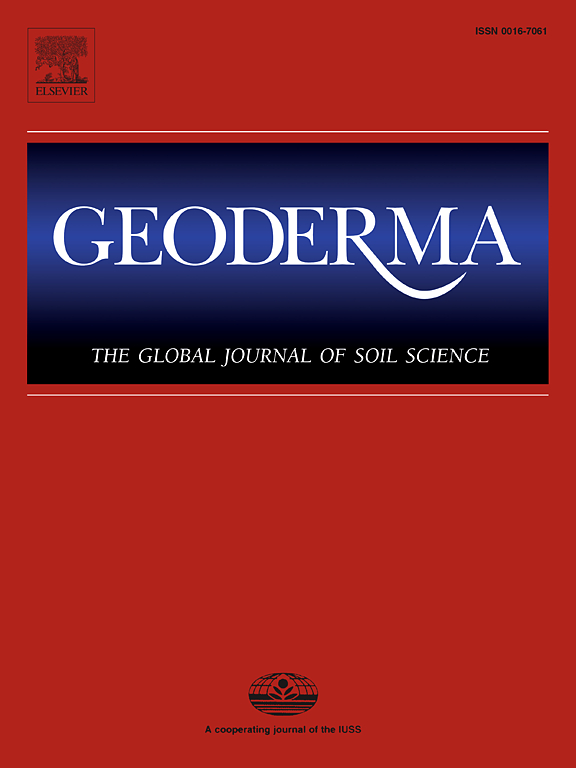Measuring in situ soil carbon stocks: A study using a novel handheld VisNIR probe
IF 5.6
1区 农林科学
Q1 SOIL SCIENCE
引用次数: 0
Abstract
To be commercially viable, soil carbon project developers need to be able to measure soil carbon stocks across large scales (e.g., 100,000 to 1,000,000 ha). These measurements need to be accurate, unbiased, inexpensive, and fast. One potential measurement modality for carbon markets is visible and near-infrared diffuse reflectance spectroscopy (VisNIR). VisNIR has been widely used to predict soil properties including soil organic carbon (SOC) concentration and stock under both lab settings and in situ soil conditions. Recent developments in low-cost spectrometers have enabled the creation of easy to operate, rapidly deployed, handheld VisNIR-equipped devices for in situ soil measurement. Our objective for this study is to 1) test one such handheld in situ VisNIR probe (handheld probe) to measure SOC stocks to 30 cm depth in Midwest US Mollisols, 2) to quantify the role of bulk density and SOC concentration in VisNIR probe calibration for probe-based estimation on SOC stock in Midwest US Mollisols, and 3) to quantify the effect of indirect (SOC + BD) vs direct calibration modeling (SOC stock directly) of SOC stocks using VisNIR data. We collected handheld probe measurements and soil core samples from six non-contiguous farms across the state of Illinois, USA. A one-farm hold out PLSR modeling approach was taken for SOC concentration, bulk density, 5-cm incremented SOC stocks down to 45 cm; and 0 to 30 cm SOC stocks using the in situ VisNIR spectra from the handheld probe. Models accurately predicted SOC concentration (R2 = 0.72, RMSE = 0.33 %, RPIQ = 2.39, bias = 0.0005 %), 5-cm increment SOC stocks (R2 = 0.68, RPIQ = 2.41 Mg/ha, bias = 0.05 Mg/ha) and 0 to 30 cm SOC stocks (R2 = 0.88, RMSEP = 7.8, bias = -0.49 Mg/ha, RPIQ = 4.19 Mg/ha). Models were not able to accurately predict bulk density (R2 = 0.28). Direct SOC stock modeling resulted in lower bias compared to indirect computation of SOC stock (bias = 0.05 and 0.15 Mg/ha for direct and indirect methods, respectively) and results demonstrated that, in this loess landscape, SOC stock prediction accuracy was driven by accurate prediction of SOC concentration, rather than accurate prediction of bulk density. The handheld probe shows promise as a rapid, low-cost tool for measuring SOC stocks in the midwestern Mollisols and can provide the data necessary to support large spatial scale soil carbon market development. These results justify continued investment in in situ spectral libraries for the handheld probes and eventually posit a modeling framework for measurement-based soil carbon accounting.
测量原位土壤碳储量:使用新型手持式VisNIR探针的研究
为了在商业上可行,土壤碳项目开发商需要能够测量大尺度(例如10万到100万公顷)的土壤碳储量。这些测量需要准确、公正、廉价和快速。碳市场的一种潜在测量方式是可见和近红外漫反射光谱(VisNIR)。VisNIR已被广泛用于预测土壤性质,包括实验室环境和原位土壤条件下的土壤有机碳(SOC)浓度和储量。低成本光谱仪的最新发展使得易于操作、快速部署、配备visir的手持式设备能够用于原位土壤测量。我们的研究目标是:1)测试一个这样的手持式原位VisNIR探针(手持式探针)来测量美国中西部Mollisols 30厘米深度的SOC储量;2)量化体积密度和SOC浓度在VisNIR探针校准中的作用,用于基于探针估计美国中西部Mollisols SOC储量;3)使用VisNIR数据量化SOC储量的间接(SOC + BD)与直接校准建模(SOC直接)的影响。我们收集了手持式探针测量和土壤核心样本从六个不连续的农场横跨伊利诺伊州,美国。采用单场hold out PLSR建模方法对土壤有机碳浓度、堆积密度、5 cm增加到45 cm的土壤有机碳储量进行建模;和0至30厘米的SOC库存使用现场VisNIR光谱从手持探头。模型准确预测了有机碳浓度(R2 = 0.72, RMSE = 0.33%, RPIQ = 2.39,偏差= 0.0005 %)、5 cm增量有机碳储量(R2 = 0.68, RPIQ = 2.41 Mg/ha,偏差= 0.05 Mg/ha)和0 ~ 30 cm有机碳储量(R2 = 0.88, RMSEP = 7.8,偏差= -0.49 Mg/ha, RPIQ = 4.19 Mg/ha)。模型不能准确预测容重(R2 = 0.28)。与间接方法相比,直接有机碳储量建模的偏差更小(直接和间接方法的偏差分别为0.05和0.15 Mg/ha),结果表明,在该黄土景观中,有机碳储量的预测精度主要取决于有机碳浓度的准确预测,而不是体积密度的准确预测。手持式探针有望成为一种快速、低成本的工具,用于测量Mollisols中西部土壤有机碳储量,并可以提供支持大空间尺度土壤碳市场发展所需的数据。这些结果证明了继续投资于手持式探针的原位光谱库,并最终为基于测量的土壤碳核算建立了一个建模框架。
本文章由计算机程序翻译,如有差异,请以英文原文为准。
求助全文
约1分钟内获得全文
求助全文
来源期刊

Geoderma
农林科学-土壤科学
CiteScore
11.80
自引率
6.60%
发文量
597
审稿时长
58 days
期刊介绍:
Geoderma - the global journal of soil science - welcomes authors, readers and soil research from all parts of the world, encourages worldwide soil studies, and embraces all aspects of soil science and its associated pedagogy. The journal particularly welcomes interdisciplinary work focusing on dynamic soil processes and functions across space and time.
 求助内容:
求助内容: 应助结果提醒方式:
应助结果提醒方式:


